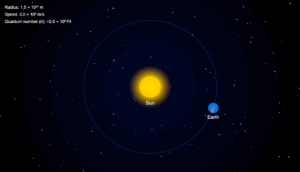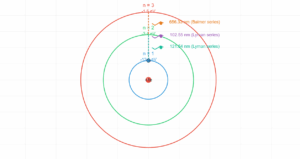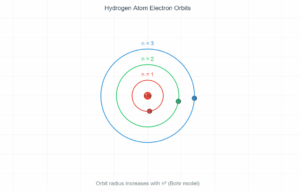Rutherford Gold Foil Experiment
Interactive simulation demonstrating alpha particle scattering through thin gold foil (1911)
Simulation Controls
Parameters
Real-time Statistics
Legend
Example
Question:
In a Geiger-Marsden experiment, what is the distance of closest approach to the nucleus of a 7.7 MeV \(\alpha\)-particle before it comes momentarily to rest and reverses its direction?
Solution:
Throughout the scattering, the total mechanical energy is conserved. Initial energy \(E_i\) (kinetic) = final energy \(E_f\) (potential) at closest approach. Let \( d \) be the center-to-center distance between \(\alpha\)-particle and gold nucleus at this point.
The conservation gives:
\[
K = \frac{1}{4\pi\epsilon_0} \frac{(2e)(Ze)}{d}
\]
\[
K = \frac{2Ze^2}{4\pi\epsilon_0 d}
\implies d = \frac{2Ze^2}{4\pi\epsilon_0 K}
\]
With \( K = 7.7~\text{MeV} = 1.2 \times 10^{-12}~\text{J} \), \( 1/4\pi\epsilon_0 = 9.0 \times 10^9~\text{N m}^2/\text{C}^2 \), \( e = 1.6 \times 10^{-19}~\text{C} \), \( Z = 79 \) for gold:
\[
d = \frac{2(9.0 \times 10^9)(1.6 \times 10^{-19})^2 Z}{1.2 \times 10^{-12}}
\]
\[
= 3.84 \times 10^{-16}~\text{Z m}
\]
For gold (\( Z = 79 \)):
\[
d(\text{Au}) = 3.0 \times 10^{-14}~\text{m} = 30~\text{fm}
\]
The actual radius of gold nucleus is about 6 fm (\( 6.0 \times 10^{-15}~\text{m} \)), which is much less than the distance of closest approach. Thus, the \(\alpha\)-particle reverses motion without touching the nucleus.
About the Experiment
In 1911, Ernest Rutherford, Hans Geiger, and Ernest Marsden conducted this groundbreaking experiment that revolutionized our understanding of atomic structure. They fired alpha particles at a thin gold foil and observed their scattering patterns.
Key Observations: Most particles passed straight through (95.5%), some deflected at small angles (4.3%), very few at large angles (0.19%), and remarkably few bounced back (0.01%). This disproved the "plum pudding" model and established that atoms have a small, dense nucleus surrounded by mostly empty space.



